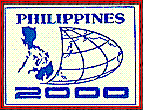General InformationCurrency: Pesos - P43.50 = $1 USD (July 3, 2000) Per capita income: $2,600 GDP: $194.2 billion GDP Growth: 1% Inflation: 8.4% Unemployment: 8.6% Labor Force: 29,130,000 Natural Resources: timber, crude oil, nickel, cobalt, silver, gold, salt, copper Agriculture: rice, coconuts, corn, sugarcane, bananas, pineapple, mangos, fish Industry: food processing, chemicals, textiles, pharmaceuticals, wood, electronics assembly, petrolium refining, fishing Exports: $20.5 billion - United States, Japan, Singapore, Hong Kong, United Kingdom Imports: $33.3 billion - Japan, United States, Saudi Arabia Note: taken from the textbook - Japan and the Pacific Rim: Fifth Edition by Dr Dean W Collinwood; McGraw-Hill Guilford Connecticut; 1999 |

The ecomony of the Philippines has been on a slow but steady upturn since the mid-1990's. In his article "The Philippines at the Crossroads" Paul D. Hutchcraft noted that the early 1990's presented a number of challenges for the then president Fidel Ramos (1). Some of the problems were the eruption of Mount Pinatubo in 1991, the departure of U.S. military bases in 1992 and a decade of slow growth. Hutchcraft classified the 1980's as the lost decade - with annual growth rates averaging about 0.9%. When Ramos came into office he announced economic reforms with a goal to liberalization and privatization. Ramos developed his plan under the banner "Philippines 2000" - an ambitious plan to make the Philippines a Newly Industrialized Country by the year 2000.
Ramos began with measures aimed at eliminating cartels and monopolies. He began with the Telecomunications industry, and used its transformation as a model for other industries. He wanted to create a "level playing field upon which entreprenurial activity can flurish" (1). Some early successes were made in the telecommunications, airline, and shipping industries. However, a major problem that President Ramos faced was the simple fact that the government, at the time, was not sufficiently strong to break all the cartels and monopolies in all key industries. An example was the banking industry - which supported liberalization as long as did not touch them. The result was that "there [was] little promise that banks [would] service the needs of small and medium scale businesses" (1).
Yet, despite the difficulties, it seems that the Philippine economy has been able to cope with its many challenges - in particular the Asian Currency Crisis of 1997. Then President Ramos made the following statement regarding the economy about six months after the crisis began:
Having taken our medicine, we are a step ahead of some other countries in facing the current challenges. We now have a policy framework that rewards economic merit instead of political access. Our banking system is sound--Morgan Stanley puts it in the same league with Hong Kong and Singapore--and we have avoided the bankruptcies that have engulfed the region. Inward investment is surging, with this year's level five times that of 1996's. And inflation is under control at just about 5%. Yes, our currency has been dragged down by the Asian contagion, but our strong macroeconomic fundamentals--the strengthening of which has been pursued relentlessly--are there for all to see. (4)
The current Filipino president, Joseph "Erap" Estrada, is building on Ramo's economic success - which is reasonable since he was Ramo's vice-president and choosen successor. In June of 1999 it was reported that foreign investments were up, as was confidence by foreign invesotrs (4). Erap announced that "the Bangko Sentral ng Pilipinas has reported for the first time in history, that the country's dollar reserves has reached an all-time high of $13.78 billion as of the end of April. In Central Luzon alone, a 75 percent year-on-year increase to P6.5 billion in fresh investments was recorded, during the January-March 1999 period, which was viewed as a "clear sign" of the increasing investor confidence in the Estrada administration" (5).
President Estrada has lead the Philippines into the the Information Age with a push to develoup the infrastructure and human capital necessary to build an electric economy. In fact, the "I Love You" computer virus which infected millions of computers around the world is thought to have originated in the Philippines - demonstrating the ability that Filipino students have (6).
The Filipino government is encoraging investment from foreign companies. For the most part, export businesses can be 100% foreign owned. Some restrictions apply to domestically oriented foreign owned business. Limitations are placed on companies wanting to do business in the domestic market by the Constitution of the Philippines itself or by national laws (2). Starting a business in the Philippines is fairly easy - the organization only has to set up a branch office in the Philippines or set up a new subsidiary (2). The Filipino government offers a variety of incentives for foreign investors including tax deductions for labor expenses, and exemtions from taxes and duties on import materials such as capital goods and spare parts. All business is conducted in English.
Restrictions are placed on the following industries: